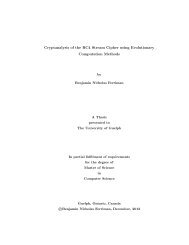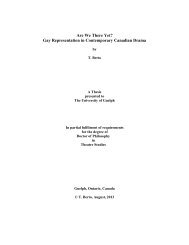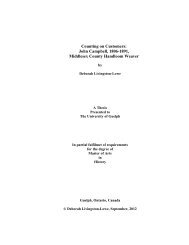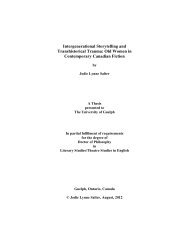THESIS - ROC CH ... - FINAL - resubmission.pdf - University of Guelph
THESIS - ROC CH ... - FINAL - resubmission.pdf - University of Guelph
THESIS - ROC CH ... - FINAL - resubmission.pdf - University of Guelph
You also want an ePaper? Increase the reach of your titles
YUMPU automatically turns print PDFs into web optimized ePapers that Google loves.
Table 2.2: Summary <strong>of</strong> cellulose particle type characteristics adapted from Moon et al. (2011).<br />
WF(Wood Fiber), PF (plant fibers), MCC (microcrystalline cellulose), MFC (micr<strong>of</strong>ibrillated<br />
cellulose), NFC (nan<strong>of</strong>ibrillated cellulose), CNC (cellulose nanocrystals).<br />
Particle<br />
Type<br />
Length<br />
(µm)<br />
Diameter<br />
(nm)<br />
13<br />
Crystallinity<br />
(%)<br />
WF and PF >2000 20-50(µm) 43-65<br />
MCC 5-10 10-50(µm) 80-85<br />
MFC 0.5-10's 10-100 51-69<br />
NFC 0.5-2 4-20 -<br />
CNC 0.05-0.5 3-5 54-88<br />
To date, all fibers in the nano range have been experimentally produced in a lab setting.<br />
The isolation process <strong>of</strong> individual nan<strong>of</strong>ibers has not yet been optimized for commercial<br />
production. Cellulose in the nano range has a natural tendency to aggregate into bundles <strong>of</strong><br />
larger dimensions, which nullify the material enhancing properties <strong>of</strong> nano fibers. Current<br />
commercially available cellulose fibers are typically larger in size with micrometer dimensions<br />
including microcrystalline cellulose (MCC), wood fibers (WF), and plant fibers (PF). MCC have<br />
been extensively used in pharmaceuticals and food industries. They are highly crystalline and<br />
are functionally applied as a binder, rheological modifier, or as reinforcement fillers. WF and PF<br />
are predominately applied in paper and textile products with much larger dimensions with<br />
relatively low crystallinity (Moon et al. 2011). For use as reinforcement fibers, higher aspect<br />
ratios are typically desired for better transfer <strong>of</strong> axial loads. This project focused on obtaining<br />
NFC and MFC fibers from stems and pods <strong>of</strong> the soy plant to reinforce extruded SPI films.<br />
2.4 CELLULOSE FIBER EXTRACTION<br />
Cellulose biosynthesis up the hierarchical ladder has inherent flaws during arrangement<br />
and ordering. Randomized amorphous packing <strong>of</strong> the cellulose fibrils creates irregularities and

















